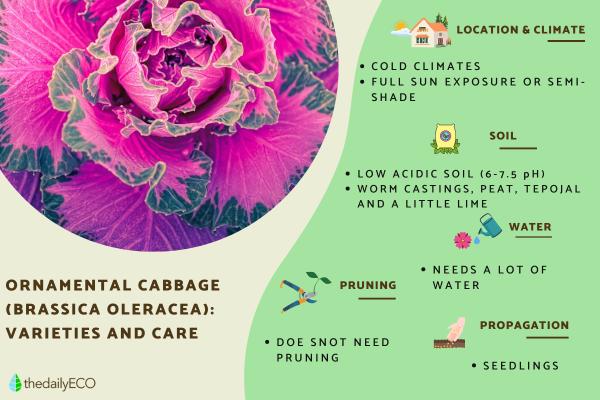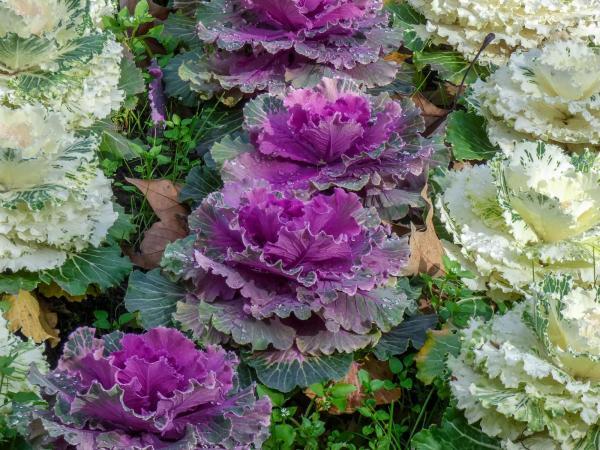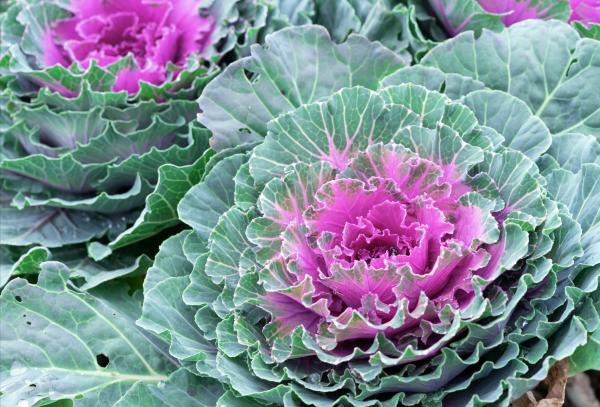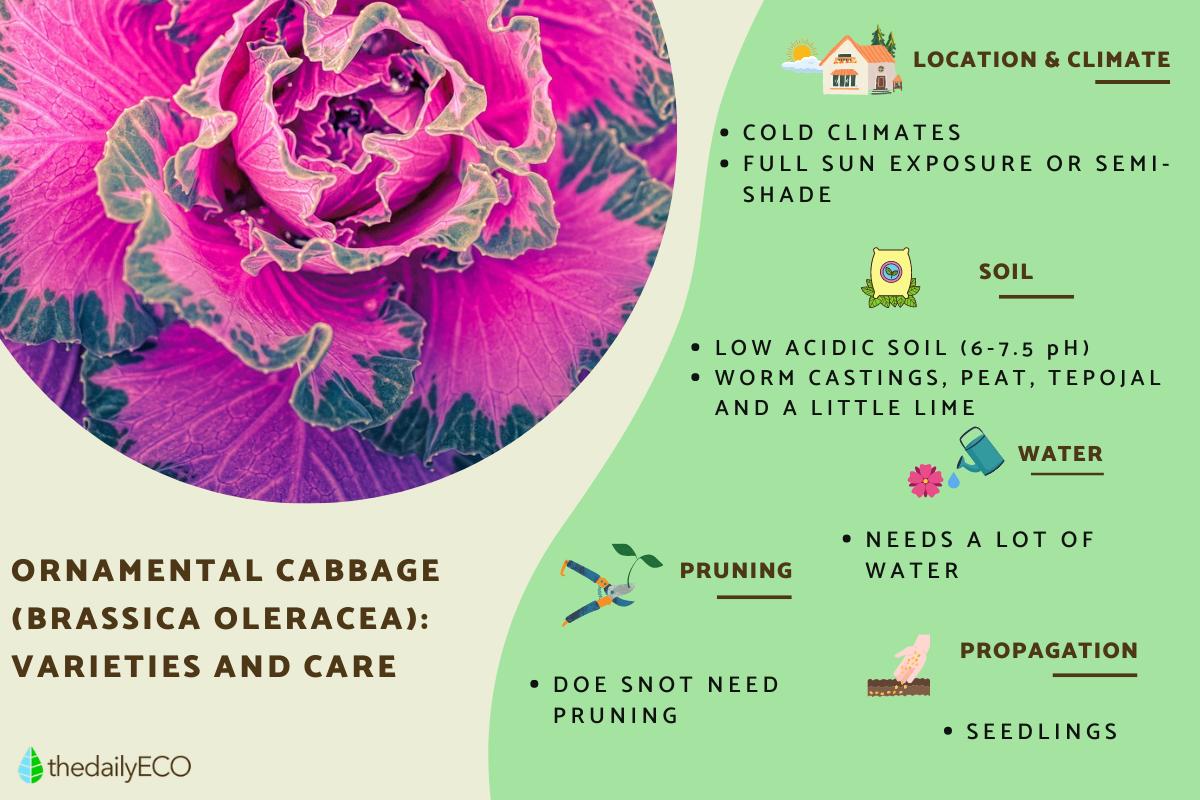Ornamental Cabbage Plant - Care Guide


Most of us know cabbage as a leafy green vegetable which is important for various cuisines around the world. Many of us know might not know about its popularity as an ornamental plant. Although we may enjoy various different types of cabbage in the kitchen, they are all from the same plant known as wild cabbage (Brassica oleracea). From this one plant species, all the different cultivars of cabbage. These include red cabbage, kale and even cauliflower. For such a beautiful plant, ornamental cabbage is very hardy and thrives in cold weather conditions. This might make it a great option for your home or garden.
At thedailyECO, we explain the ornamental cabbage plant care guide. We show you everything you need to grow an ornamental cabbage, the different varieties of ornamental cabbage that exist and how to propagate this plant if you want to develop more.
Varieties of ornamental cabbage
Ornamental cabbage develops thick and slightly glossy rosette-shaped leaves. They are native to difficult environments that are high in salinity and limestone. It is for this reason they have thick leaves to be able to store water and nutrients. This allows them to overcome harsh weather conditions.
There is a great variety of cabbages that are ornamental due to their aesthetic properties. They have a wide range of colors such as purple, pink, white and green. These colors will be seen when the first maturation arrives during the first year of the plant's life. It is the colors which often determine the name of the cultivar. Some of the most common types of ornamental cabbage cultivars are the following:
- Osaka pink: this cultivar features pink to purple leaves with ruffled edges, creating a rosette-like appearance.
- Osaka red: similar to Osaka pink, but with deep red leaves, adding a rich color to garden displays.
- Osaka white: known for its white to cream-colored leaves, which stand out in garden beds or containers.
- Osaka green: this cultivar has green leaves with a slight purple tinge, adding a unique touch to the garden.
- Peacock white: a cultivar with soft white leaves that have a lacy or fringed edge, resembling a peacock's feathers.
- Peacock red: similar to peacock white, but with deep red foliage, creating an eye-catching contrast.
- Kamome red: this cultivar has vibrant red and pink leaves, creating a beautiful display of color.
- Kamome white: known for its green and white variegated leaves, adding a striking pattern to garden arrangements.
- Color-up pink: this cultivar features pink leaves that intensify in color as the weather gets colder.
- Color-up white: a cultivar with white leaves that also intensify in color with cooler temperatures.
- Color-up red: this cultivar has red leaves that deepen in color during cooler weather.
- Pigeon red: a cultivar with deep red-purple leaves that add a dramatic touch to garden designs.
Although they can be a beautiful ornamental plant, it is important to note cabbages are biennial. This means they die two years after germination. It is often treated as an annual plant to be consumed, since the youngest first-year leaves are edible. Ornamental cabbages flower in the first year, so you will have to decide whether you want to eat the cabbage or watch it bloom.
The cabbage will use the nutrients stored in the leaves to develop the flower stalks. When in flower, it attracts many pollinators such as butterflies and pollen beetles. Normally, the flower is light yellow in color, although this can depend on the cultivar.
We have been learning about an edible plant which is used as ornament. In our article on edible types of cacti, you can learn about ornamental plants which are also edible.

Ornamental cabbage light, temperature and placement
It is a plant that adapts very well to different temperature conditions, although it prefers temperate to humid climates. These should be around 15-ºC/59-64.4 ºF. It tolerates frost very well. In fact, these very cold temperatures are what will promote the bright and striking colors.
It can be kept in direct sunlight, but also in partial shade. This last option is very useful when cabbage is used as a ground cover. During very cold winters it is necessary to always have it under the sun.
Ornamental cabbage soil and compost
The cabbage needs a soil that is not too acidic, as well as being fertile and very firm. To achieve this, prepare a mixture of soil with peat as a base, an equal part of worm casting to provide nutrients, a handful of tepojal to promote drainage and very small handful of lime. This will help to make it slightly more alkaline. To find out if it will be necessary to add lime, a soil pH test can be done by dissolving a little soil in water and measuring with pH strips. This should read a pH of 6 to 7.5. It also tolerates a neutral soil of 5 pH, but it should not be less than this number.
It should be fertilized once a year with a fertilizer that has a high content of phosphorus and potassium. This is because this helps strengthen against fungal diseases and pests. It is necessary to avoid nitrogen because it increases the possibility of the appearance of fungi.
Learn about the best homemade organic fertilizers with our related article.

Ornamental cabbage watering
Alkaline soil does not absorb water very well and causes stagnation. With all the aforementioned needs, this means ornamental cabbage requires abundant watering. You have to be checking that the soil is always wet, but not flooded. The preparation of the soil is key to avoid excess water.
Ornamental cabbage health
Cabbage does not need pruning because it always maintains its compact shape. You have to pay attention to certain pests that can attack it. These include caterpillars, pigeons and snails . This is more frequent when the plants are young. Once the ornamental cabbage is established the probability of pests decreases considerably.
It can be susceptible to fungi that cause white powder. To combat this problem, it is recommended to temporarily reduce watering and avoid wetting the leaves. As a preventive measure, we should consider planting it in the direction where the wind blows to increase ventilation and reduce the probability of a fungal infestation of the plant.

How to propagate ornamental cabbage
Cabbage can be reproduced by seeding. Cabbage seeds are obtained in the second year of the plant's life, or in specialized horticulture stores. These will be planted indoors at the beginning of August so that the seedlings can grow protected from the cold. They need more abundant irrigation than when they are adults. Once grown they can be taken outside.
Learn about caring for other plants with our articles on how to care for bottlebrush plants and balsam plant care.
If you want to read similar articles to Ornamental Cabbage Plant - Care Guide, we recommend you visit our Plant care and cultivation category.
- Weatherington, M. (2017). Gardening in the South: The Complete Homeowner's Guide. Oregon: Timber Press.
- Department of Primary Industries and Regional Development. (2017) White blister disease in vegetable brassica crops. Retrieved from: https://www.agric.wa.gov.au/broccoli/white-blister-disease-vegetable-brassica-crops?page=0%2C1#smartpaging_toc_p1_s0_h2
- Royal Horticultural Society. (n.d.). Brassica oleracea. Retrieved from: https://www.rhs.org.uk/plants/search-results?form-mode=true&query=brassica%20oleracea








